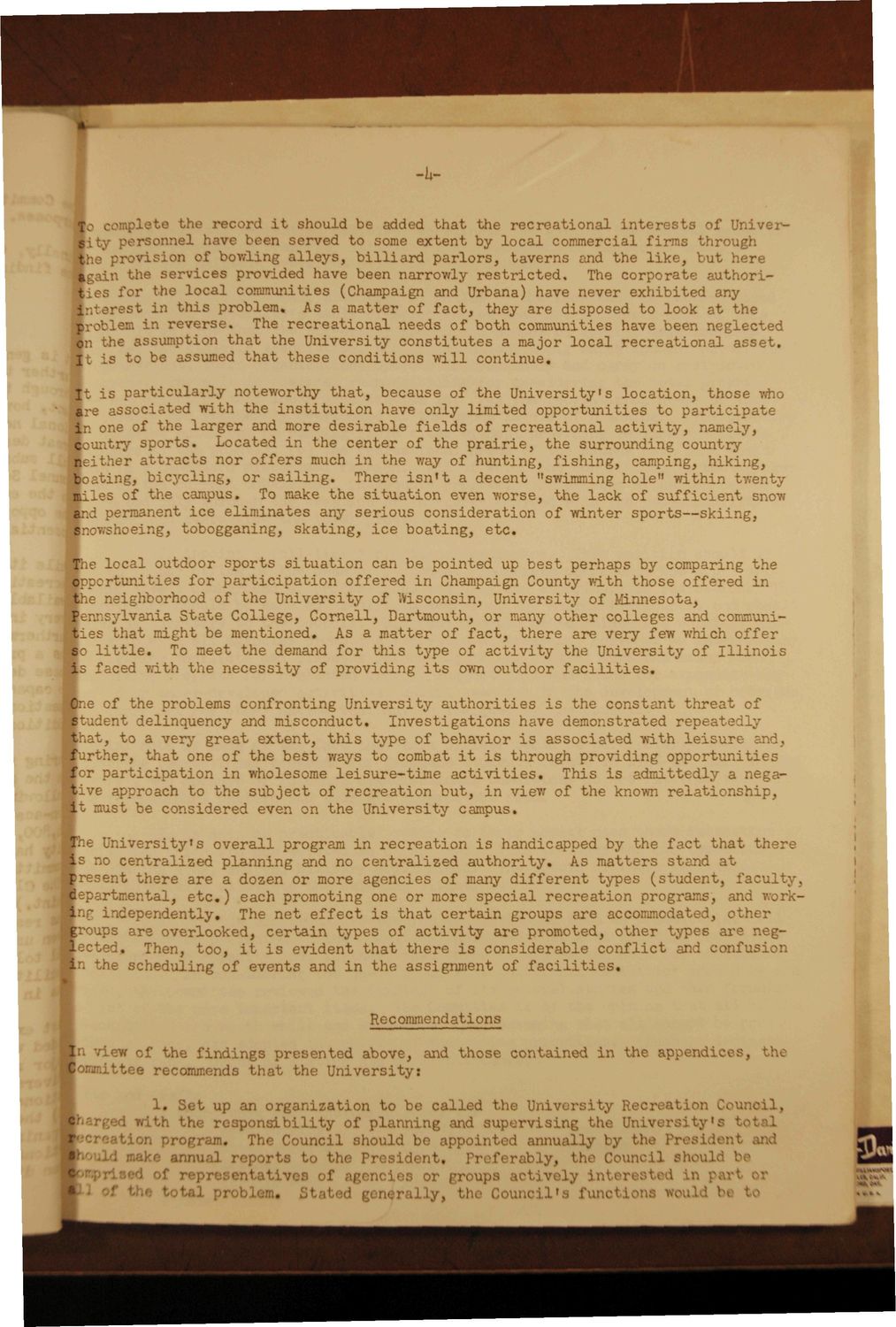| |
| |
Caption: Book - Report on Need for Campus Recreation Facilities (1947)
This is a reduced-resolution page image for fast online browsing.

EXTRACTED TEXT FROM PAGE:
-ll- jo tnplete the record it should be added that the recreational interests of Universe t y rsonnel have been served to some extent by local commercial firms through the provision of bowling alleys, billiard parlors, taverns and the like, but here again the services provided have been narrowly restricted. The corporate authorities for the local communities (Champaign and Urbana) have never exhibited any interest in this problem. As a matter of fact, they are disposed to look at the aroblem in reverse. The recreational needs of both communities have been neglected I n the assumption that the University constitutes a major local recreational asset. It is to be assumed that these conditions will continue. It is particularly noteworthy that, because of the University's location, those who are associated with the institution have only limited opportunities to participate in one of the larger and more desirable fields of recreational activity, namely, country sports. Located in the center of the prairie, the surrounding country neither attracts nor offers much in the way of hunting, fishing, camping, hiking, boating, bicycling, or sailing. There isn't a decent "swimming hole" within twenty miles of the campus. To make the situation even worse, the lack of sufficient snow and permanent ice eliminates any serious consideration of winter sports—skiing, sr.ov/shoeing, tobogganing, skating, ice boating, etc. The local outdoor sports situation can be pointed up best perhaps by comparing the opportunities for participation offered in Champaign County with those offered in the neighborhood of the University of Wisconsin, University of Minnesota, Pennsylvania State College, Cornell, Dartmouth, or many other colleges and communities that might be mentioned. As a matter of fact, there are very few which offer so little. To meet the demand for this type of activity the University of Illinois is faced with the necessity of providing its own outdoor facilities. One of the problems confronting University authorities is the constant threat of student delinquency and misconduct. Investigations have demonstrated repeatedly that, to a very great extent, this type of behavior is associated with leisure and, further, that one of the best ways to combat it is through providing opportunities for participation in wholesome leisure-time activities. This is admittedly a negative approach to the subject of recreation but, in view of the known relationship, it must be considered even on the University campus. The University's overall program in recreation is handicapped by the fact that there is no centralized planning and no centralized authority. As matters stand at present there are a dozen or more agencies of many different types (student, faculty, lepartmental, etc.) each promoting one or more special recreation programs, and working independently. The net effect is that certain groups are accommodated, other groups are overlooked, certain types of activity are promoted, other types are neglected. Then, too, it is evident that there is considerable conflict and confusion In the scheduling of events and in the assignment of facilities. j : | Recommendations In view of the findings presented above, and those contained in the appendices, the 1' ittee recommends that the University: I 1. Set up an organization to be called the Univ ;ity Rec at i with the responsibility of planning and supervising the Univt dty's it: -of un. The Council should be appointed annually by t i make annual j >orts to the President. Pr -ably, tho Council should rised of rep* mtatlvcs of agencj i or -oups actively interea i in d f i total p o . i . iJ -ited gene e rb' y, >uncil s fund i w s oil. t al i and t be • or «• •
| |